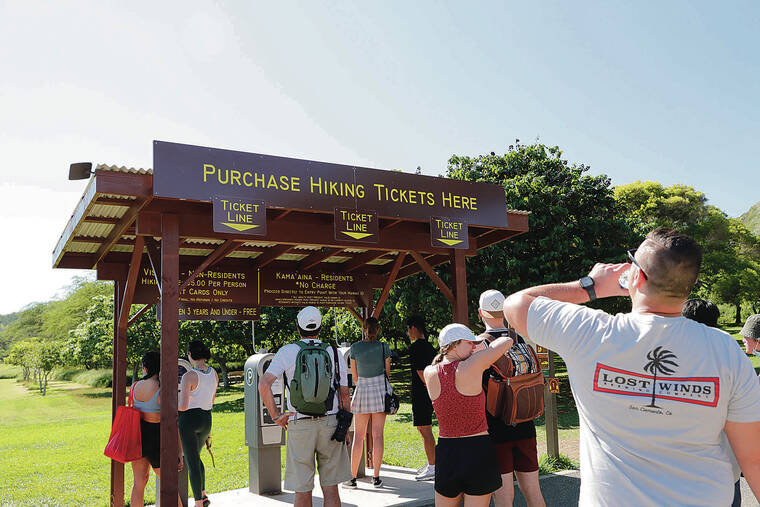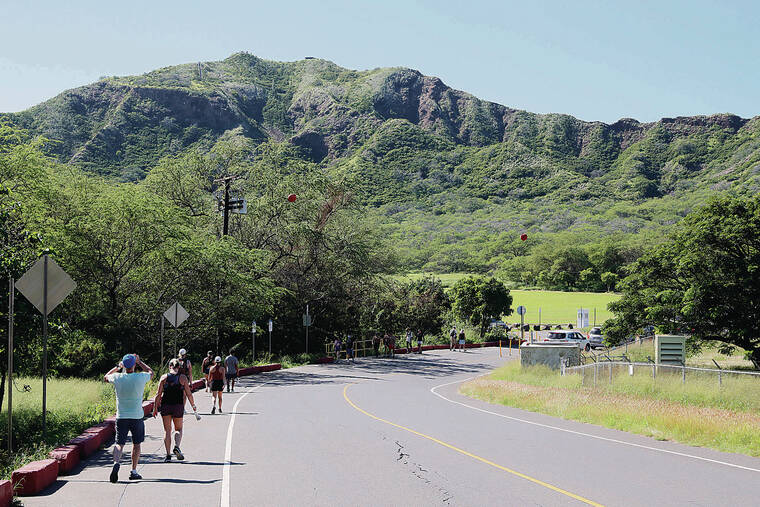With tourism arrivals forecast to reach just below 10 million by the end of 2024 — and the state prohibited from limiting the number of visitors — some legislators feel pressure to expand parking and user fees at state parks designed to charge tourists for their impact on state lands.
Hawaii is expected to see 8.86 million visitors this year, followed by 9.531 million in 2023 and then 9.996 million
in 2024 — just shy of record-
breaking arrivals of more than 10 million annually before the era of COVID-19.
Tourism arrivals since the economy all but shut down in early 2020 due to COVID-19 have created a renewed sense of urgency to better manage tourism, especially by expanding parking fees and user fees
at popular state parks.
The Hawaii Tourism Authority approved the Oahu Destination Management Action Plan
in 2021 with a main goal of decreasing tourists to the island.
HTA hopes to meet the goal by “managing the number of visitor accommodations, and exploring changes to land use, zoning and airport policies.”
House Speaker Scott Saiki told the Honolulu Star-Advertiser’s “Spotlight Hawaii” livestream program last week that the user fees at state parks are designed “to have visitors pay their fair share when they visit Hawaii.”
Senate President Ron Kouchi appeared with Saiki on “Spotlight Hawaii” and said the projection of nearly 10 million visitors less than three years from now means, “It becomes even more important to maintain some semblance of control of the flow of the visitors. How do we protect our infrastructure? How do we ensure positive outcomes for our residents and the visitors alike? And how do we make sure that visitors are paying for the impacts they are creating on our infrastructure and the natural
resource?”
He added, “We could be generating over $20 million a year without adding any new taxes
to what we have, and that would be committed to upgrading our infrastructure, protecting the natural resource, hiring the
adequate personnel to wind up doing the enforcement and then the personnel to maintain the
facilities like the bathrooms in these areas. And so I think that that’s going to be an important tool going forward in managing the visitors that come and protecting the resource.”
About 10 state parks across the islands are either charging or planning to charge some form of parking and user fees, but even more should be under consideration, said state Sen. Glenn Wakai (D, Kalihi-Salt Lake-
Aliamanu), chairman of the Senate Energy, Economic
Development, Tourism and Technology Committee.
The new model emerged at Haena State Park on Kauai’s north shore following devastating floods and mudslides in 2018 that wiped out Kuhio Highway and isolated communities. In 2019 the state also began charging entry and parking fees at Koke‘e and Waimea Canyon state parks on the Garden Isle.
On Oahu, only tourists — not residents with proper ID — have been assessed
entry and parking fees at Diamond Head since 2021, along with parking fees at Nu‘uanu Pali State Wayside, more commonly referred to as the Pali Lookout.
Similar fees are in place for Wai‘anapanapa State Park near Hana on Maui and Maui’s ‘Iao Needle.
Wakai also would like to see parking and user fee collections better managed by implementing “dynamic pricing” during the more popular — and less popular — tourist seasons.
“That’s where government doesn’t know how to run like the private sector,” Wakai said. “Government doesn’t know how to respond to the peaks and valleys in tourism.”
Wakai understands the
desire by some residents to limit the number of visitor arrivals to Hawaii. But he and state Rep. Richard Onishi (D, South Hilo-Keaau-Honuapo), who chairs the House Labor and Tourism Committee, said that’s beyond state control.
How many visitors come to Hawaii “is up to the market,” Onishi said.
The Commerce Clause of the U.S. Constitution gives Congress the power to regulate commerce between states and other nations, not individual states.
“No. The state is in no position to cap the number of visitors here,” Wakai said. “That’s market control. We don’t control what airlines can come in here and with what size planes or how many seats.”
Onishi said legislators such as himself are eager to learn about other models from around the world to better manage the tourists who arrive in Hawaii. But New Zealand’s “green fees” won’t be legal in Hawaii unless every resident has to pay them along with each visitor — also because of the Commerce Clause, Onishi said.
America’s Founding Fathers originally met in Philadelphia over the issue of interstate commerce.
“The Articles of Confederation were a problem because the states were competing against each other, so they set up a federal government,” said professor Avi Soifer, former dean of the University of Hawaii’s William S. Richardson School of Law, who continues to teach constitutional law.
“The Commerce Clause is complicated,” Soifer emphasized. “But there’s got to be free flow of commerce, including people, across state lines. States can’t set up barriers even if we want our
representatives to do so. If we want to look out just for local residents, the Commerce Clause says you can’t.”
So far, Onishi said he has heard of no other way to restrict tourism that would work in Hawaii.
The limits frustrate Wakai.
“A lot of people are griping and groaning how things could be better,” Wakai said. “I hear a lot of people groaning. I hear very few people coming up with solutions.”
In the meantime Hawaii continues to see its tourism numbers grow — especially from the mainland — despite a new surge in COVID-
19 cases because of international travel restrictions and continuing pent-up travel demand, Onishi said.
Eventually, Hawaii’s COVID-19-restricted international travel market will rebound, as well.
So until new ideas emerge to better manage tourism, efforts are likely to continue this legislative session to build a more efficient system to manage access to
Hawaii’s state parks through parking and user fees.




